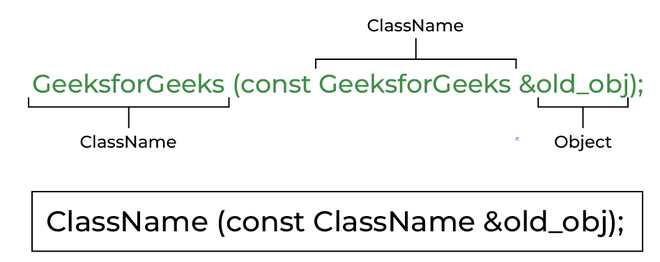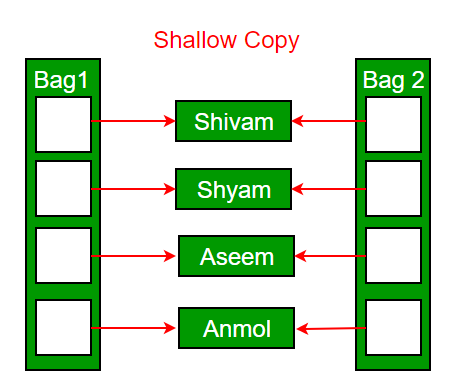Pre-requisite: Constructor in C++
A copy constructor is a member function that initializes an object using another object of the same class. In simple terms, a constructor which creates an object by initializing it with an object of the same class, which has been created previously is known as a copy constructor.
Copy constructor is used to initialize the members of a newly created object by copying the members of an already existing object.
Copy constructor takes a reference to an object of the same class as an argument.
Sample(Sample &t)
{
id=t.id;
}
The process of initializing members of an object through a copy constructor is known as copy initialization.
It is also called member-wise initialization because the copy constructor initializes one object with the existing object, both belonging to the same class on a member by member copy basis.
The copy constructor can be defined explicitly by the programmer. If the programmer does not define the copy constructor, the compiler does it for us.
Example:

Syntax of Copy Constructor
C++
#include <iostream>
#include <string.h>
using namespace std;
class student {
int rno;
char name[50];
double fee;
public:
student(int, char[], double);
student(student& t)
{
rno = t.rno;
strcpy(name, t.name);
fee = t.fee;
}
void display();
};
student::student(int no, char n[], double f)
{
rno = no;
strcpy(name, n);
fee = f;
}
void student::display()
{
cout << endl << rno << "\t" << name << "\t" << fee;
}
int main()
{
student s(1001, "Manjeet", 10000);
s.display();
student manjeet(s);
manjeet.display();
return 0;
}
|
Output
1001 Manjeet 10000
1001 Manjeet 10000
C++
#include <iostream>
#include <string.h>
using namespace std;
class student {
int rno;
char name[50];
double fee;
public:
student(int, char[], double);
student(student& t)
{
rno = t.rno;
strcpy(name, t.name);
}
void display();
void disp() { cout << endl << rno << "\t" << name; }
};
student::student(int no, char n[], double f)
{
rno = no;
strcpy(name, n);
fee = f;
}
void student::display()
{
cout << endl << rno << "\t" << name << "\t" << fee;
}
int main()
{
student s(1001, "Manjeet", 10000);
s.display();
student manjeet(s);
manjeet.disp();
return 0;
}
|
Output
1001 Manjeet 10000
1001 Manjeet
Characteristics of Copy Constructor
1. The copy constructor is used to initialize the members of a newly created object by copying the members of an already existing object.
2. Copy constructor takes a reference to an object of the same class as an argument. If you pass the object by value in the copy constructor, it would result in a recursive call to the copy constructor itself. This happens because passing by value involves making a copy, and making a copy involves calling the copy constructor, leading to an infinite loop. Using a reference avoids this recursion. So we use reference of Objects to avoid infinite calls.
Sample(Sample &t)
{
id=t.id;
}
3. The process of initializing members of an object through a copy constructor is known as copy initialization.
4. It is also called member-wise initialization because the copy constructor initializes one object with the existing object, both belonging to the same class on a member-by-member copy basis.
5. The copy constructor can be defined explicitly by the programmer. If the programmer does not define the copy constructor, the compiler does it for us.
Example:
C++
#include <iostream>
using namespace std;
class Point {
private:
int x, y;
public:
Point(int x1, int y1)
{
x = x1;
y = y1;
}
Point(const Point& p1)
{
x = p1.x;
y = p1.y;
}
int getX() { return x; }
int getY() { return y; }
};
int main()
{
Point p1(10, 15);
Point p2 = p1;
cout << "p1.x = " << p1.getX()
<< ", p1.y = " << p1.getY();
cout << "\np2.x = " << p2.getX()
<< ", p2.y = " << p2.getY();
return 0;
}
|
Output
p1.x = 10, p1.y = 15
p2.x = 10, p2.y = 15
Types of Copy Constructors
1. Default Copy Constructor
An implicitly defined copy constructor will copy the bases and members of an object in the same order that a constructor would initialize the bases and members of the object.
C++
#include <iostream>
using namespace std;
class Sample {
int id;
public:
void init(int x) { id = x; }
void display() { cout << endl << "ID=" << id; }
};
int main()
{
Sample obj1;
obj1.init(10);
obj1.display();
Sample obj2(obj1);
obj2.display();
return 0;
}
|
2. User Defined Copy Constructor
A user-defined copy constructor is generally needed when an object owns pointers or non-shareable references, such as to a file, in which case a destructor and an assignment operator should also be written
C++
#include <iostream>
using namespace std;
class Sample {
int id;
public:
void init(int x) { id = x; }
Sample() {}
Sample(Sample& t)
{
id = t.id;
}
void display() { cout << endl << "ID=" << id; }
};
int main()
{
Sample obj1;
obj1.init(10);
obj1.display();
Sample obj2(
obj1);
obj2.display();
return 0;
}
|
C++
#include <iostream>
#include <string.h>
using namespace std;
class student {
int rno;
string name;
double fee;
public:
student(int, string, double);
student(student& t)
{
rno = t.rno;
name = t.name;
fee = t.fee;
}
void display();
};
student::student(int no, string n, double f)
{
rno = no;
name = n;
fee = f;
}
void student::display()
{
cout << endl << rno << "\t" << name << "\t" << fee;
}
int main()
{
student s(1001, "Ram", 10000);
s.display();
student ram(s);
ram.display();
return 0;
}
|
Output
1001 Ram 10000
1001 Ram 10000
When is the copy constructor called?
In C++, a Copy Constructor may be called in the following cases:
- When an object of the class is returned by value.
- When an object of the class is passed (to a function) by value as an argument.
- When an object is constructed based on another object of the same class.
- When the compiler generates a temporary object.
It is, however, not guaranteed that a copy constructor will be called in all these cases, because the C++ Standard allows the compiler to optimize the copy away in certain cases, one example is the return value optimization (sometimes referred to as RVO).
Copy Elision
In copy elision, the compiler prevents the making of extra copies which results in saving space and better the program complexity(both time and space); Hence making the code more optimized.
Example:
C++
#include <iostream>
using namespace std;
class GFG {
public:
void print() { cout << " GFG!"; }
};
int main()
{
GFG G;
for (int i = 0; i <= 2; i++) {
G.print();
cout << "\n";
}
return 0;
}
|
Now it is on the compiler to decide what it wants to print, it could either print the above output or it could print case 1 or case 2 below, and this is what Return Value Optimization is. In simple words, RVO is a technique that gives the compiler some additional power to terminate the temporary object created which results in changing the observable behavior/characteristics of the final program.
Case 1:
GFG!
GFG!
Case 2:
GFG!
When is a user-defined copy constructor needed?
If we don’t define our own copy constructor, the C++ compiler creates a default copy constructor for each class which does a member-wise copy between objects. The compiler-created copy constructor works fine in general. We need to define our own copy constructor only if an object has pointers or any runtime allocation of the resource like a file handle, a network connection, etc.
The default constructor does only shallow copy.

Deep copy is possible only with a user-defined copy constructor. In a user-defined copy constructor, we make sure that pointers (or references) of copied objects point to new memory locations.

Copy constructor vs Assignment Operator
The main difference between Copy Constructor and Assignment Operator is that the Copy constructor makes a new memory storage every time it is called while the assignment operator does not make new memory storage.
Which of the following two statements calls the copy constructor and which one calls the assignment operator?
MyClass t1, t2;
MyClass t3 = t1; // ----> (1)
t2 = t1; // -----> (2)
A copy constructor is called when a new object is created from an existing object, as a copy of the existing object. The assignment operator is called when an already initialized object is assigned a new value from another existing object. In the above example (1) calls the copy constructor and (2) calls the assignment operator. See this for more details.
Example – Class Where a Copy Constructor is Required
Following is a complete C++ program to demonstrate the use of the Copy constructor. In the following String class, we must write a copy constructor.
Example:
C++
#include <cstring>
#include <iostream>
using namespace std;
class String {
private:
char* s;
int size;
public:
String(const char* str = NULL);
~String() { delete[] s; }
String(const String&);
void print()
{
cout << s << endl;
}
void change(const char*);
};
String::String(const char* str)
{
size = strlen(str);
s = new char[size + 1];
strcpy(s, str);
}
void String::change(const char* str)
{
delete[] s;
size = strlen(str);
s = new char[size + 1];
strcpy(s, str);
}
String::String(const String& old_str)
{
size = old_str.size;
s = new char[size + 1];
strcpy(s, old_str.s);
}
int main()
{
String str1("GeeksQuiz");
String str2 = str1;
str1.print();
str2.print();
str2.change("GeeksforGeeks");
str1.print();
str2.print();
return 0;
}
|
Output
GeeksQuiz
GeeksQuiz
GeeksQuiz
GeeksforGeeks
What would be the problem if we remove the copy constructor from the above code?
If we remove the copy constructor from the above program, we don’t get the expected output. The changes made to str2 reflect in str1 as well which is never expected.
C++
#include <cstring>
#include <iostream>
using namespace std;
class String {
private:
char* s;
int size;
public:
String(const char* str = NULL);
~String() { delete[] s; }
void print() { cout << s << endl; }
void change(const char*);
};
String::String(const char* str)
{
size = strlen(str);
s = new char[size + 1];
strcpy(s, str);
}
void String::change(const char* str) { strcpy(s, str); }
int main()
{
String str1("GeeksQuiz");
String str2 = str1;
str1.print();
str2.print();
str2.change("GeeksforGeeks");
str1.print();
str2.print();
return 0;
}
|
Output:
GeeksQuiz
GeeksQuiz
GeeksforGeeks
GeeksforGeeks
Can we make the copy constructor private?
Yes, a copy constructor can be made private. When we make a copy constructor private in a class, objects of that class become non-copyable. This is particularly useful when our class has pointers or dynamically allocated resources. In such situations, we can either write our own copy constructor like the above String example or make a private copy constructor so that users get compiler errors rather than surprises at runtime.
Why argument to a copy constructor must be passed as a reference?
A copy constructor is called when an object is passed by value. Copy constructor itself is a function. So if we pass an argument by value in a copy constructor, a call to the copy constructor would be made to call the copy constructor which becomes a non-terminating chain of calls. Therefore compiler doesn’t allow parameters to be passed by value.
Why argument to a copy constructor should be const?
One reason for passing const reference is, that we should use const in C++ wherever possible so that objects are not accidentally modified. This is one good reason for passing reference as const, but there is more to it than ‘Why argument to a copy constructor should be const?’
Share your thoughts in the comments
Please Login to comment...